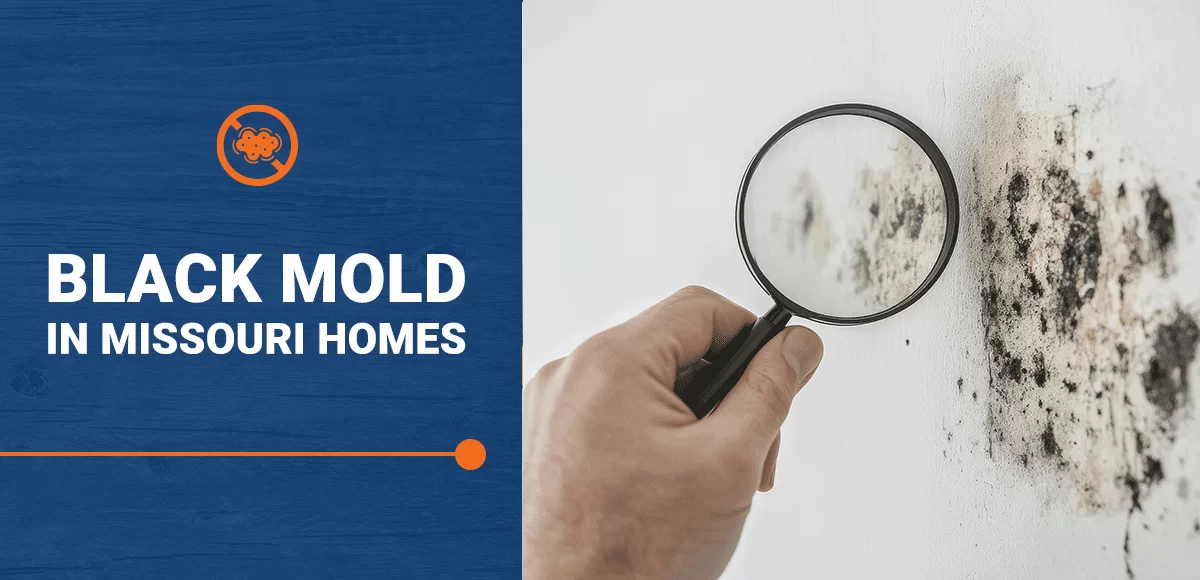Unmasking the Silent Threat: Black Mold in Missouri Homes
June 17, 2025

Missouri’s climate, with its humid summers and occasional heavy rainfall, can unfortunately create ideal conditions for mold growth in homes. Among the various types of mold, “black mold,” specifically Stachybotrys chartarum, often raises significant concern due to its potential health implications. But what exactly is black mold, why is it dangerous, how can you identify it, and most importantly, what should you do if you find it in your Missouri home?
What is “Black Mold”?
When people refer to “black mold,” they’re usually talking about Stachybotrys chartarum. This particular species of mold typically appears dark green or black and often has a slimy or wet texture when active, though it can become powdery when dry. Unlike some other molds that might be black in color, Stachybotrys chartarum is notorious for producing mycotoxins – toxic compounds that can become airborne and impact indoor air quality.
It’s important to remember that not all black mold is Stachybotrys chartarum. Many types of mold can appear black. However, any visible mold growth, regardless of color, indicates a moisture problem that needs to be addressed.
Why is Black Mold Dangerous?
The primary concern with Stachybotrys chartarum lies in the mycotoxins it can produce. Exposure to these mycotoxins can lead to a range of health issues, particularly for individuals with allergies, asthma, or compromised immune systems. Common symptoms associated with black mold exposure include:
Respiratory Problems: Persistent coughing, sneezing, wheezing, shortness of breath, and nasal congestion. It can also worsen existing asthma or allergy symptoms and, in some cases, lead to respiratory infections.
Irritation: Itchy or watery eyes, irritated nose or throat, and skin rashes.
Neurological Symptoms: Headaches, dizziness, fatigue, difficulty concentrating, and even memory loss or mood changes in more severe cases.
Other Symptoms: Sore throat, nosebleeds, and chronic fatigue.
Beyond health risks, black mold can also cause significant structural damage to your home. It thrives on organic materials like wood, drywall, insulation, and carpeting, slowly weakening their integrity over time if left unaddressed.
How to Identify Black Mold
Identifying black mold in your Missouri home often involves a combination of visual cues and a distinct odor:
Appearance: Look for dark green or black patches, often with a slimy or fuzzy texture. It can also appear powdery if the moisture source has dried up.
Location: Black mold typically thrives in damp, dark environments where moisture is consistently present. Common areas include:
Basements and crawl spaces, especially after flooding or water intrusion.
Attics with roof leaks or poor ventilation.
Bathrooms and kitchens with high humidity or leaky pipes.
Behind walls or under flooring where water damage has occurred.
Odor: A strong, persistent musty, earthy, or “decaying” smell is a telltale sign of mold growth, even if you can’t see it. This odor is due to microbial volatile organic compounds (mVOCs) produced by molds.
Water Damage: Any history of water leaks, flooding, or excessive condensation in an area increases the likelihood of mold growth. Look for water stains, warped drywall, or peeling paint.
Unexplained Health Issues: If you or your family members experience persistent allergy-like symptoms or other health concerns that seem to worsen indoors, especially in specific areas of the house, mold could be a culprit.
While visual identification and smell are strong indicators, definitively identifying Stachybotrys chartarum requires professional testing by a certified mold inspection specialist. However, the general consensus is that any visible mold should be treated seriously and removed, regardless of its specific species.
What to Do About Black Mold
If you suspect or confirm black mold in your Missouri home, it’s important to take swift and appropriate action.
For Small Areas (less than 10 square feet):
Address the Moisture Source: This is the most critical first step. Fix any leaks, improve ventilation, or dehumidify the affected area. If the moisture source isn’t resolved, the mold will return.
Personal Protective Equipment (PPE): Wear an N-95 respirator mask (available at hardware stores), rubber or latex gloves, and goggles (without air vents) to prevent inhaling spores or skin contact.
Containment: If possible, seal off the affected area with plastic sheeting to prevent spores from spreading. Turn off fans and HVAC systems.
Cleaning: Scrub the moldy surface with a mild detergent and water mixture. The University of Missouri Extension suggests avoiding bleach, as it can be a lung irritant and may not effectively kill mold on porous surfaces. For non-porous surfaces that were wet from floodwater or sewer backup, a solution of 1 part bleach to 10 parts water can be used for disinfection, but use with caution and ensure good ventilation.
Drying: Dry the area completely before attempting any painting or caulking. Mold will grow through paint.
Discard Porous Materials: It’s almost impossible to completely remove mold from porous materials like carpet, drywall, insulation, and upholstered furniture. These items should be discarded if they cannot be thoroughly dried within 24-48 hours.
For Larger Areas (greater than 10 square feet) or Hidden Mold:
Do Not Disturb: Resist the urge to scrub or spray large patches of mold, as this can release a massive amount of spores into the air, making the problem worse.
Call a Professional: For extensive mold growth, hidden mold, or if you have health concerns, it’s highly recommended to contact a certified mold remediation professional in Missouri. They have the expertise, specialized equipment (like HEPA air scrubbers and vacuums), and proper protocols to safely and effectively remove mold and prevent its recurrence. Many companies offer free estimates.
Document Everything: Take photos of visible damage for insurance purposes.
What to Do About Black Mold
Prevention is always the best approach. Given Missouri’s climate, consider these tips:
Control Humidity: Keep indoor humidity levels between 30% and 50% using dehumidifiers, especially in basements and crawl spaces.
Fix Leaks Promptly: Address any plumbing leaks, roof leaks, or condensation issues immediately.
Ensure Proper Ventilation: Use exhaust fans in bathrooms and kitchens, and ensure good airflow in attics and other moisture-prone areas.
Regular Inspections: Periodically check for signs of mold, especially in areas prone to moisture.
Clean and Dry: If materials get wet, dry them thoroughly within 24-48 hours to prevent mold growth.
Black mold can be a serious issue, but by understanding what it is, its potential dangers, how to identify it, and what steps to take, Missouri homeowners can protect their health and their homes. When in doubt, always consult with a qualified professional.
